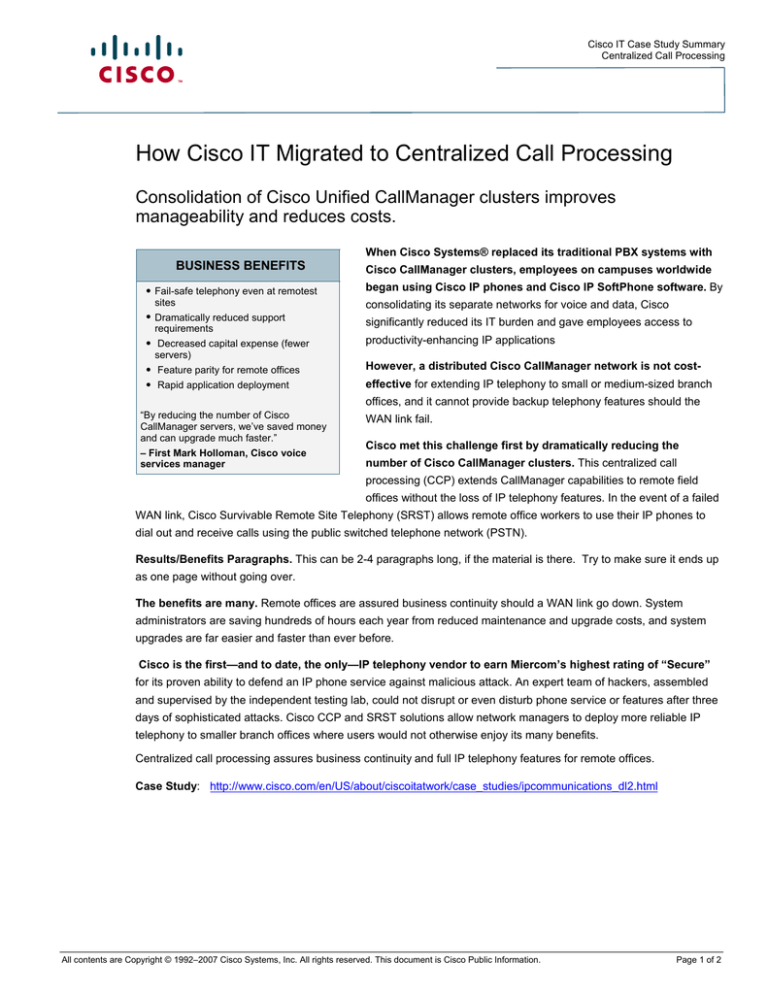
Cisco IT Case Study Summary
Centralized Call Processing
How Cisco IT Migrated to Centralized Call Processing
Consolidation of Cisco Unified CallManager clusters improves
manageability and reduces costs.
When Cisco Systems® replaced its traditional PBX systems with
BUSINESS BENEFITS
● Fail-safe telephony even at remotest
sites
● Dramatically reduced support
requirements
● Decreased capital expense (fewer
Cisco CallManager clusters, employees on campuses worldwide
began using Cisco IP phones and Cisco IP SoftPhone software. By
consolidating its separate networks for voice and data, Cisco
significantly reduced its IT burden and gave employees access to
productivity-enhancing IP applications
servers)
● Feature parity for remote offices
However, a distributed Cisco CallManager network is not cost-
● Rapid application deployment
effective for extending IP telephony to small or medium-sized branch
offices, and it cannot provide backup telephony features should the
“By reducing the number of Cisco
CallManager servers, we’ve saved money
and can upgrade much faster.”
– First Mark Holloman, Cisco voice
services manager
WAN link fail.
Cisco met this challenge first by dramatically reducing the
number of Cisco CallManager clusters. This centralized call
processing (CCP) extends CallManager capabilities to remote field
offices without the loss of IP telephony features. In the event of a failed
WAN link, Cisco Survivable Remote Site Telephony (SRST) allows remote office workers to use their IP phones to
dial out and receive calls using the public switched telephone network (PSTN).
Results/Benefits Paragraphs. This can be 2-4 paragraphs long, if the material is there. Try to make sure it ends up
as one page without going over.
The benefits are many. Remote offices are assured business continuity should a WAN link go down. System
administrators are saving hundreds of hours each year from reduced maintenance and upgrade costs, and system
upgrades are far easier and faster than ever before.
Cisco is the first—and to date, the only—IP telephony vendor to earn Miercom’s highest rating of “Secure”
for its proven ability to defend an IP phone service against malicious attack. An expert team of hackers, assembled
and supervised by the independent testing lab, could not disrupt or even disturb phone service or features after three
days of sophisticated attacks. Cisco CCP and SRST solutions allow network managers to deploy more reliable IP
telephony to smaller branch offices where users would not otherwise enjoy its many benefits.
Centralized call processing assures business continuity and full IP telephony features for remote offices.
Case Study: http://www.cisco.com/en/US/about/ciscoitatwork/case_studies/ipcommunications_dl2.html
All contents are Copyright © 1992–2007 Cisco Systems, Inc. All rights reserved. This document is Cisco Public Information.
Page 1 of 2
Cisco IT Case Study Summary
Centralized Call Processing
FOR MORE INFORMATION
To read the entire case study or for additional Cisco IT case studies on a variety of business solutions, visit Cisco on
Cisco: Inside Cisco IT www.cisco.com/go/ciscoit
NOTE
This publication describes how Cisco has benefited from the deployment of its own products. Many factors may have
contributed to the results and benefits described; Cisco does not guarantee comparable results elsewhere.
CISCO PROVIDES THIS PUBLICATION AS IS WITHOUT WARRANTY OF ANY KIND, EITHER EXPRESS OR
IMPLIED, INCLUDING THE IMPLIED WARRANTIES OF MERCHANTABILITY OR FITNESS FOR A PARTICULAR
PURPOSE.
Some jurisdictions do not allow disclaimer of express or implied warranties, therefore this disclaimer may not apply to
you.
All contents are Copyright © 1992–2007 Cisco Systems, Inc. All rights reserved. This document is Cisco Public Information.
Page 2 of 2


